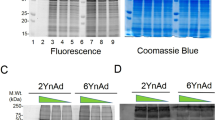Abstract
Poly(ADP-ribosyl)ation (PARylation), i.e., the formation of the nucleic acid-like biopolymer poly(ADP-ribose) (PAR), is an essential posttranslational modification carried out by poly(ADP-ribose) polymerases (PARPs). While PAR levels are low under physiological conditions, they can transiently increase more than 100-fold upon induction of genotoxic stress. The accurate quantitation of cellular PAR with high sensitivity is of critical importance to understand the role of PARylation in cellular physiology and pathophysiology and to determine the pharmacodynamic efficiencies of clinically relevant PARP inhibitors, which represent a novel class of promising chemotherapeutics. Previously, we have developed a bioanalytical platform based on isotope dilution mass spectrometry (LC-MS/MS) to quantify cellular PAR with unequivocal chemical specificity in absolute terms with femtomol sensitivity (Martello et al. ACS Chem Biol 8(7):1567–1575, 2013). This method enables the analysis of steady-state levels, as well as stress-induced levels of PAR in various biological systems including cell lines, mouse tissues, and primary human lymphocytes. It has a wide range of potential applications in basic research, as well as in drug development (Martello et al. ACS Chem Biol 8(7):1567–1575, 2013; Mangerich et al. Toxicol Lett 244:56–71, 2016). Here, we present an improved and adjusted version of the original protocol by Martello/Mangerich et al., which uses UPLC-MS/MS instrumentation.
Access this chapter
Tax calculation will be finalised at checkout
Purchases are for personal use only
Similar content being viewed by others
References
Martello R, Mangerich A, Sass S, Dedon PC, Burkle A (2013) Quantification of cellular poly(ADP-ribosyl)ation by stable isotope dilution mass spectrometry reveals tissue- and drug-dependent stress response dynamics. ACS Chem Biol 8(7):1567–1575. doi:10.1021/cb400170b
Juarez-Salinas H, Sims JL, Jacobson MK (1979) Poly(ADP-ribose) levels in carcinogen-treated cells. Nature 282(5740):740–741
Juarez-Salinas H, Levi V, Jacobson EL, Jacobson MK (1982) Poly(ADP-ribose) has a branched structure in vivo. J Biol Chem 257(2):607–609
Kanai M, Miwa M, Kuchino Y, Sugimura T (1982) Presence of branched portion in poly(adenosine diphosphate ribose) in vivo. J Biol Chem 257(11):6217–6223
Shah GM, Poirier D, Duchaine C, Brochu G, Desnoyers S, Lagueux J, Verreault A, Hoflack JC, Kirkland JB, Poirier GG (1995) Methods for biochemical study of poly(ADP-ribose) metabolism in vitro and in vivo. Anal Biochem 227(1):1–13
Aboul-Ela N, Jacobson EL, Jacobson MK (1988) Labeling methods for the study of poly- and mono(ADP-ribose) metabolism in cultured cells. Anal Biochem 174(1):239–250. 0003-2697(88)90541-6 [pii]
Shah GM, Kandan-Kulangara F, Montoni A, Shah RG, Brind'amour J, Vodenicharov MD, Affar el B (2011) Approaches to detect PARP-1 activation in vivo, in situ, and in vitro. Methods Mol Biol 780:3–34. doi:10.1007/978-1-61779-270-0_1
Horvath EM, Zsengeller ZK, Szabo C (2011) Quantification of PARP activity in human tissues: ex vivo assays in blood cells and immunohistochemistry in human biopsies. Methods Mol Biol 780:267–275. doi:10.1007/978-1-61779-270-0_16
Ida C, Yamashita S, Tsukada M, Sato T, Eguchi T, Tanaka M, Ogata S, Fujii T, Nishi Y, Ikegami S, Moss J, Miwa M. An enzyme-linked immunosorbent assay-based system for determining the physiological level of poly(ADP-ribose) in cultured cells. Anal Biochem. 2016 Feb 1;494:76–81. doi: 10.1016/j.ab.2015.10.014. PubMed PMID: 26548958.
Kawamitsu H, Hoshino H, Okada H, Miwa M, Momoi H, Sugimura T (1984) Monoclonal antibodies to poly(adenosine diphosphate ribose) recognize different structures. Biochemistry 23(16):3771–3777
Fahrer J, Kranaster R, Altmeyer M, Marx A, Bürkle A (2007) Quantitative analysis of the binding affinity of poly(ADP-ribose) to specific binding proteins as a function of chain length. Nucleic Acids Res 35(21):e143. doi:10.1093/nar/gkm944
Liu S, Wang Y (2015) Mass spectrometry for the assessment of the occurrence and biological consequences of DNA adducts. Chem Soc Rev 44(21):7829–7854. doi:10.1039/c5cs00316d
Tretyakova N, Goggin M, Sangaraju D, Janis G (2012) Quantitation of DNA adducts by stable isotope dilution mass spectrometry. Chem Res Toxicol 25(10):2007–2035. doi:10.1021/tx3002548
Mangerich A, Knutson CG, Parry NM, Muthupalani S, Ye W, Prestwich E, Cui L, McFaline JL, Mobley M, Ge Z, Taghizadeh K, Wishnok JS, Wogan GN, Fox JG, Tannenbaum SR, Dedon PC (2012) Infection-induced colitis in mice causes dynamic and tissue-specific changes in stress response and DNA damage leading to colon cancer. Proc Natl Acad Sci U S A 109(27):E1820–E1829. doi:10.1073/pnas.1207829109
Mangerich A, Debiak M, Birtel M, Ponath V, Balszuweit F, Lex K, Martello R, Burckhardt-Boer W, Strobelt R, Siegert M, Thiermann H, Steinritz D, Schmidt A, Burkle A (2016) Sulfur and nitrogen mustards induce characteristic poly(ADP-ribosyl)ation responses in HaCaT keratinocytes with distinctive cellular consequences. Toxicol Lett 244:56–71. doi:10.1016/j.toxlet.2015.09.010
Brabeck C, Pfeiffer R, Leake A, Beneke S, Meyer R, Bürkle A (2003) L-selegiline potentiates the cellular poly(ADP-ribosyl)ation response to ionizing radiation. J Pharmacol Exp Ther 306(3):973–979
Acknowledgments
This work was supported by the DFG-funded Konstanz Research School Chemical Biology (KoRSCB), by the Collaborative Research Center (CRC) 969, and by the German Federal Ministry of Defense.
This chapter represents an updated protocol for the quantitation of poly(ADP-ribose) by isotope dilution mass spectrometry in cells and tissues, which is based on a previous publication by Martello/Mangerich et al. [1]. Parts of the original publication are reprinted with permission of the American Chemical Society (ACS).
Author information
Authors and Affiliations
Corresponding author
Editor information
Editors and Affiliations
Rights and permissions
Copyright information
© 2017 Springer Science+Business Media LLC
About this protocol
Cite this protocol
Zubel, T., Martello, R., Bürkle, A., Mangerich, A. (2017). Quantitation of Poly(ADP-Ribose) by Isotope Dilution Mass Spectrometry. In: Tulin, A. (eds) Poly(ADP-Ribose) Polymerase. Methods in Molecular Biology, vol 1608. Humana Press, New York, NY. https://doi.org/10.1007/978-1-4939-6993-7_1
Download citation
DOI: https://doi.org/10.1007/978-1-4939-6993-7_1
Published:
Publisher Name: Humana Press, New York, NY
Print ISBN: 978-1-4939-6992-0
Online ISBN: 978-1-4939-6993-7
eBook Packages: Springer Protocols




